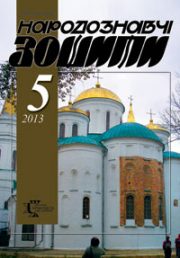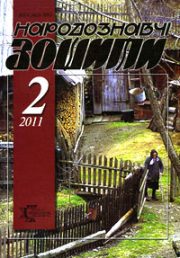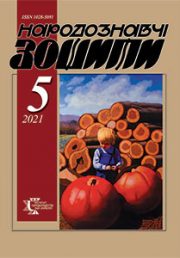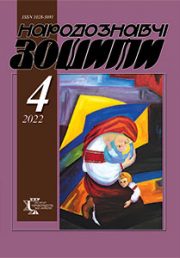The Ethnology Notebooks. 2024. № 1 (175), 3—15
UDK [[77.064:069.5]:[726:27-523]](477.8)
DOI https://doi.org/10.15407/nz2024.01.003
TARAS Yaroslav
- ORCID ID: https://orcid.org/0000-0001-7241-9466
- Doctor of Historical Sciences, Professor,
- Institute of Ethnology of the National Academy of Sciences of Ukraine,
- Head of the Modern Ethnology Department,
- 15, Svobody Avenue, 79000, Lviv, Ukraine,
- Lviv Polytechnic National University,
- Department of Architecture and Conservation, Professor,
- 12, Bandery street, 79013, Lviv, Ukraine,
- Contacts: e-mail: etnomod@ukr.net
Abstract. Formulation of the problem. Photographs and negatives of V. Shcherbakivsky are an important source for studying the genesis of Ukrainian sacred building, architecture, folk art, and ethnography. They are the basis for the restoration of the artistic tradition, remain relevant, and go far beyond the boundaries of historiographical discourse.
The article highlights the cooperation of V. Shcherbakivsky with the National Academy of Sciences, his scientific research in Galicia at the beginning of the 20th century and in the Poltava region, it is shown how the collected visual sources allowed V. Shcherbakivsky to assert the existence of an independent «Ukrainian church style» that Ukrainian artistic tradition is a confirmation of national identity, it is highlighted how his photo-fixation of Ukrainian church architecture became an important factor in breaking the Great Russian thing in the appropriation of other people’s achievements.
The purpose of the article is to publicize and analyze information about Vadym Shcherbakivsky’s negatives, which are stored in the funds of the Institute of Ethnology of the National Academy of Sciences of Ukraine, to show his familiarity with photographic practice, to highlight their value for architecture, folk art, ethnology, and church history. It is shown how visual sources serve as artifacts for the study of architecture, folk art, ethnology and Church history, the tasks set for the processing and digitization of photographs and negatives of V. Shcherbakivsky and the publication of an album for the 150th anniversary of his birth.
The object of the study is the legacy of V. Shcherbakivsky’s negatives, collected by the Museum of the National Academy of Sciences.
The subject of the research is the practice of using visual materials by Vadym Shcherbakivsky to study the genesis of Ukrainian sacred building, folk art, ethnography and to restore the artistic tradition.
Keywords: ethnology, architecture,Vadym Shcherbakivsky, Shevchenko Scientific Society, Museum of the National Academy of Sciences, Institute of Ethnology of the National Academy of Sciences of Ukraine, Boykivshchyna, Hutsulshchyna, Zakarpattia, Pokuttia, the genesis of Ukrainian sacred architecture.
Received 1.07.2023
REFERENCES
- Franko, А. & Franko, O. (2012). Analysis of documents and material of V. Scherbakivsky personal fund. Proceeding of the Institute of Archaeology (Issue 7, pp. 62—74) [in Ukrainian].
- Pavlychko, Ya. (1995). Contribution of Vadym Shcherbakivsky to the development of the collection of the National Museum in Lviv. Poltava archaeological collection, 4, 105—115) [in Ukrainian].
- Shcherbakivsky, V. & Shcherbakivsky, D. (2015). Ukrainian art: in two volumes with addition: reprint. Kharkiv: O.O. Savchuk Publisher.
- Shcherbakivsky, V. (1909). Architecture of the different nations. Lviv: Narodne Slovo [in Ukrainian].
- Uvarova. (Ed.). (1908). The brief report on the excursion made in the summer of 1904 on behalf of the Moscow Archaeological Society by student Vadym Shcherbakivsky to photograph churches. Proceeding of the thirteenth Archaeological Congress in Yekaterinoslav 1905 (Vol. 2, sec. III, pp. 87—88). Moscow [in Russian].
- Shcherbakivsky, V. (1904). On the question of the types of ancient Ukrainian churches. Archaeological Chronicle of South Russia, 6, 232—236) [in Russian].
- Hnatyuk, V. (1904). Word on time. Dilo, 199, 1) [in Ukrainian].
- Nestulya, S. (1995). M.F. Bilyashivsky and V.M. Shcherbakivsky. Poltava archaeological collection, 4, 149—153) [in Ukrainian].
- Taras, Ya. (2007). Sacral wooden architecture of Ukrainians of Carpathians: the cultural-traditional aspect. Lviv [in Ukrainian].
- Taras, Ya. (2016). Mykhailo Zubrytsky in the history of the temple of the village of Mshanets. Mykhailo Zubrytskyi. Collected works and materials: in three volumes (Vol. 2, pp. 489—500). Lviv: Litopys [in Ukrainian].
- Shcherbakivsky, V. (1906). Wooden churches in Ukraine and their types. Notes of the Shevchenko Scientific Society (Vol. LXXIV, book 6, pp. 10—32) [in Ukrainian].
- Shcherbakivsky, V. (1910). Architecture of the different nations and in Ukraine. Lviv; Kyiv [in Ukrainian].
- Nazariiv, O., & Shcherbakivsky, V. (1913). Review of publ. Ukrainian art. I. Wooden construction and wood carving. Notes of NTSh (Vol. CXVI, book IV, pp. 215—220). Lviv; Kyiv [in Ukrainian].
- Shcherbakivsky, V. (1913). Churches in the Boykivshchyna. Notes of NTSh (Vol. CXIV, book 2, pp. 5—24) [in Ukrainian].
- Grabar, I. (1912). History of Russian art: in 6 vols. (Vol. II). Moscow: І. Knebel publishing house [in Russian].
- Shcherbakivsky, V. (1913). Ukrainian art. Part 1: Wooden construction and wood carving = L’architecture et la sculpture en bois. Lviv; Kyiv [in Ukrainian, in French].
- Нrebenyak, V. (1913). Review of publ. V. Shcherbakivsky. Ukrainian art. I. Wooden construction and wood carving. Literary-scientific bulletin (Vol. 64, book 10, pp. 188—190). Lviv; Kyiv [in Ukrainian].
- Antonovych, D. (1914). Rev. In front of Europe. Siajvo, 1.
- Pavlovsky, M. (1913). [Review]. Rada, 224 [in Ukrainian].
- Ulyanovsky, V. (1995). Vadym Shcherbakivsky: life, scientific activity, fate of creative heritage. In the book: Shcherbakivsky, V. Ukrainian Art: Selected Unpublished Works (Pp. 5—101). Kyiv: Lybid [in Ukrainian].
- [Review], 1913. Old years, 11/12, 42—43 [in Ukrainian].
- Shyrotsky, K. (1913, 18 oct.). [Review]. Rada (P. 4) [in Ukrainian].







